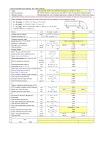
About Lamons
Lamons is one of the largest gasket and bolt suppliers in the world, committed to quality and local service. We have 6 manufacturing and 21 sales and services branches positioned all around the world combined with many licensees and distributors. We are strategically located to provide customers with the widest selection of gasket materials and fastener stock ready for immediate delivery. Lamons’ various locations feature leading technology and state of the art manufacturing facilities capable of producing engineered products to custom specifications serving the refining, chemical, power generation, offshore, subsea, petrochemical (upstream and downstream), and pulp and paper industries, among others.Table of Contents :-
Introduction
Chapter 1 : Gasket Selection
- Section 1: Non-Metallic Gaskets
- Section 2: Semi-Metallic Gaskets
- Section 3: Metallic Gaskets
- Section 4: IsoTekTM Isolation Gaskets & Kits
Chapter 3: Technical & Design
Chapter 4: Appendix
Gaskets are used to create a static seal between two stationary members of a mechanical assembly and to maintain that seal under operating conditions, which may vary dependent upon changes in pressures and temperatures. If it were possible to have perfectly mated flanges and if it were possible to maintain an intimate contact of these perfectly mated flanges throughout the extremes of operating conditions, a gasket would not be required.
This is virtually impossible either because of:
- The size of the vessel and/or the flanges;
- The difficulty in maintaining such extremely smooth flange finishes during handling and assembly;
- Corrosion and erosion of the flange surface during operations; and,
- The sheer number of flanged joints in a typical industrial setting, and commercial implications.
As a consequence, relatively inexpensive gaskets are used to provide the sealing element in these mechanical assemblies. In most cases, the gasket provides a seal by utilizing external forces to fl ow the gasket material into the imperfections between the mating surfaces. It follows then that in a properly designed gasket closure, three major considerations must be taken into account in order for a satisfactory seal to be achieved.
- Sufficient force must be available to initially seat the gasket. Stated this way, adequate means must be provided to fl ow the gasket into the imperfections in the gasket seating surfaces.
- Sufficient forces must be available to maintain a residual stress on the gasket under operating conditions to ensure that the gasket will be in continuous intimate contact with the gasket seating surfaces to prevent leakage.
- The selection of the gasket material must be such that it will withstand the pressures exerted against the gasket, satisfactorily resist the entire temperature range to which the closure will be exposed and withstand corrosive attack of the confined medium.








-page-001.jpg)



0 Comments